Advanced Core Stability Exercises for Mobile Children
Core stability refers to the strength in your tummy and back and the amount of control and balance between the two sets of muscles. Core stability refers to the strength in your tummy and back and the amount of control and balance between the two sets of muscles. More advanced core stability is generally built up as we develop and try out new and more complex movements.
Some children lag behind in their gross motor skills. They don’t seem to be as coordinated as their peers, don’t enjoy physical activities or can’t keep up in the playground. This can occur for so many reasons but one of the common reasons is that our children have weak core strength and stability. Working on this area can be the key in helping your child meet their milestones. Even if their core isn’t the principle reason for any delay, strengthening the core has a knock on effect on the rest of the body so is a great place to start.
This page gives you ideas, information and activities to help to develop further your child’s core stability. If these exercises are too difficult for your child, go to our section on core exercises for your child with developmental delay to refine their basic core skills.
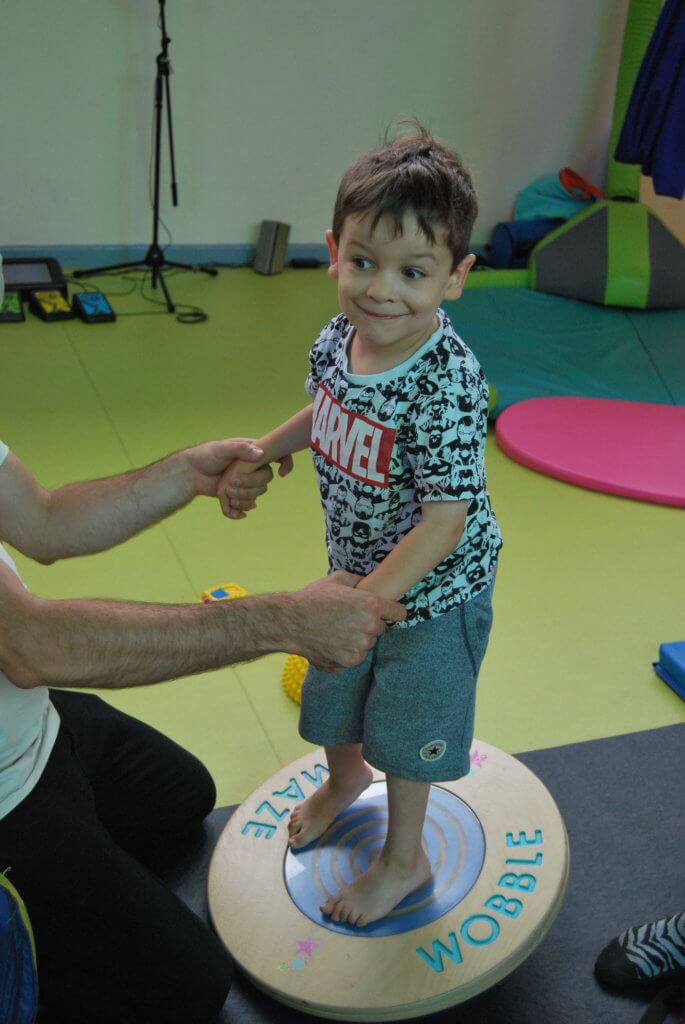
Core stability is key to the workings of your whole body. If you have good core stability, both your arms and legs will work better as they are attached to a stable base. With a good core it is much easier to have good fine and gross motor skills (movement skills).
A better core allows your child to balance in different positions. It enables them to stay still and balanced while their arms and legs work (e.g. walking) or to stay upright when you are on a moving surface (e.g. on a bus).
Our bodies are constantly seeking balance so having a better core allows your child to concentrate better as they don’t have to concentrate on staying upright and still.
-
Here are some core stability exercises to work through with your child. Go down the list and find the first level that they would find a little difficult. This is your starting point. Practice that activity until they can manage it well. If they can’t manage a certain activity, move them back a section or try the next section. You can be practicing several exercises/ activities at the same time to be more effective.
-
Make sure your child is successful in their game as this will motivate them to continue. As you push them to get to the next level, they should be able to manage a few of their attempts to keep motivated-even if they are not successful every time.
-
Remember to praise the effort made rather than the result achieve to motivate your child to keep putting in effort and not be put off if they don’t succeed at first.
-
As with all exercise, the more the child does for themselves, the better they will learn. You can help a little to show them the way but try to let them do as much for themselves as you can, even allowing them to make mistakes or fall (safely). Make your hands softer or give them a bit more time to work it out for themselves and you will see them improve quicker.
Core stability exercises and activities
Once your child is pulling up to standing on furniture, try challenging their core by standing them on a wobble cushion (a cushion filled with air) or use a sofa cushion to challenge their core a bit more. You could also try standing with 1 foot on a raised surface (a big book or box) to challenge them further.
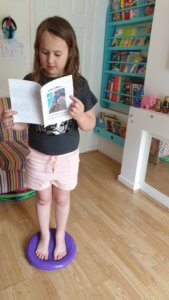
Ask them to reach to the side and down to pick up objects/ hit a drum/ post an object in a container etc.
Pushing a trolley, cruising along furniture and standing with their backs to the wall are also lovely exercises to strengthen the core before a child can walk on their own.
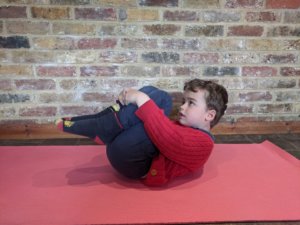
Your child lies on their back and lifts their legs to their chest and holds on to their knees with their arms. See if they can lift their head and hold up to 20 seconds in the ball shape without rolling over or dropping their head.
Try playing ball in this position – keep your knees up but hold a ball behind your head and then throw it towards your feet. The adult can then hold the ball above the child’s feet for the child to come and pick up again.
In the same position, throw a ball in the air and the child needs to kick the ball up in the air back to you with both feet.
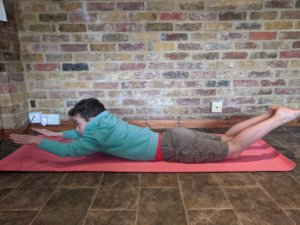
Lie flat on your tummy with arms up in front of you and legs straight behind you. Try to lift your arms and head up off the floor and hold for 20 seconds.
Next try to lift just your legs and hold for 20 seconds.
And now try to lift arms and legs at the same time. This may be easier over a gym ball.
You could roll a ball back and forward out in front of you from this position as a rolling game or to knock down some skittles.
Now try to get to 1 minute in each exercise
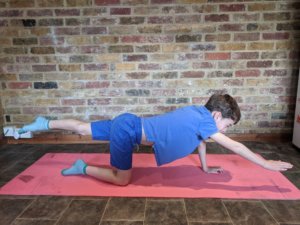
On their hands and knees – reach 1 arm straight out in front of them in the air – you can challenge them to balance a beanbag or soft toy on the back of their hand to keep it up. Try and hold for 20 seconds.
Now try and lift 1 leg straight out behind them. Try and hold this for 20 seconds.
Can they do an opposite arm and leg at the same time and hold it for 20 seconds?
Try the other side.
Try for 1 minute
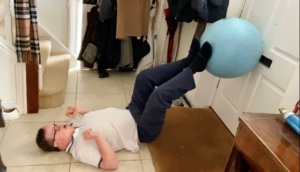
Your child should lie on their back with their feet on a gym/physio ball (or on a cushion if there is no ball available) against the wall. Move the cushion/ ball up and down the wall and then side to side. Try drawing a picture or writing their name.
Now with the ball on the floor, your child should lie on their back with their heels resting on the ball. Firstly see if your child can keep their feet on the ball without it rolling to the side. Next, your child should try to keep the ball still while you try to move the ball side to side.
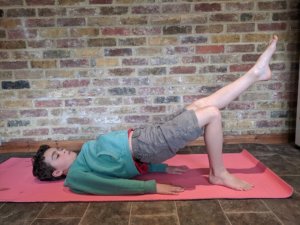
Lie your child on their back with their knees bent and feet on the floor or on your lap. Encourage them to lift their bottom up and try and hold it up for 20 seconds. You can try to drive some cars or other toys under their bottom to help encourage them to hold it up. They can also try to hold a ball between their knees while they do this to prevent their knees for falling outwards.
Lie your child on their back with their knees bent and feet on the floor or on your lap. Encourage them to lift 1 leg in the air with a straight knee or crossed over the other leg. Now lift their bottom and ask them to try to keep their bottom up for 20 seconds with their hips staying level.
Lying on their back with their knees bent and 1 leg up. Lift their bottom and try lowering their straight leg down and up again. (The straight leg shouldn’t go lower than the other knee).
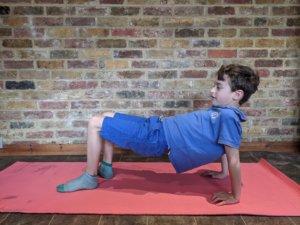
Sat on the floor and with their hands out behind them, facing their feet and with their knees bent (feet on the floor). Encourage your child to lift their bottom up and hold it so they make the shape of a table.
Try walking around like this.
Make it more challenging by balancing a toy or even a ball on their tummy while they walk around in all directions.
They could pretend to be different animals and make a game of it – try being a snake on the floor, or bear walk on hands and feet, or kangaroo jumps. Make an obstacle course and challenge your child to complete it as different animals.
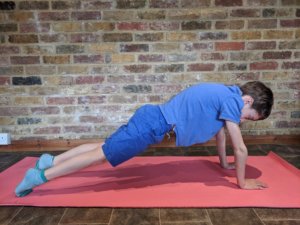
Get your child to lie on their tummy and put their hands at chest level. Help them to push up so that their weight is just on their hands and their toes. Get them to hold this position for as long as they can. Make sure their bottom isn’t up in the air but that they also aren’t letting their tummy sag down. Drive some cars under them to encourage your child to keep it up.
Do this facing a sibling and try clapping 1 of their hands to one of your hands. See how many claps your child can do – try to get to 20 claps.
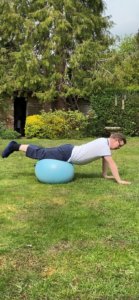
These should be done with help from an adult to make sure they are safe.
Sit on a gym ball and try and balance while you move your bottom around.
Get them to lift 1 foot off the floor and keep balancing.
Get them to try and lift both feet off the floor.
Get them to roll over the ball on their tummy until their hands reach the floor. Keep them walking forward on their hands until only their feet are still on the ball. Walk backwards until they are fully back on the ball. You can make this more interesting by picking up puzzle pieces and doing a puzzle or by picking up beanbags to throw into a bucket.
Get them to lie on their back on the gym ball. Hold your child’s feet as they reach for an object on the floor behind the ball. Ask the child to bring the object back up to throw into a container for an extreme sit up.
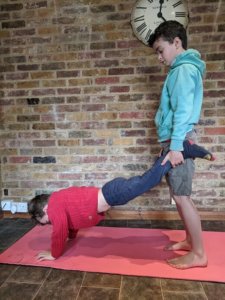

Wheelbarrow walking is incredibly challenging but brilliant for our children. Not only does it strengthen the core but it is also brilliant for shoulder and arm stability – essential for good fine motor skills – which can be problematic for children with DS. As it is so challenging, try to give more support rather than moving down this sequence too quickly as they may give up too quickly if it is far too hard for them.
Hold your child by their hips with their legs straddling you and their hands on the floor. Move around the floor picking up objects for as far as you can go.
Move your hands down to your child’s knees and walk around the room – picking up objects or playing a matching game or skittles.
If you can, hold your child by their ankles. Make sure they keep their bottom in the air and don’t hang their tummy’s down. Again find a game to make this more entertaining.
As your child gets stronger you could try to get from one end of the house to another – even trying going up the stairs.
You could also make an obstacle course to go around.
Climbing stairs requires much control and stability, both going up but more especially coming down. For these exercises, make sure you always stay on the step or 2 steps below your child to help them if they get unsteady.
To start with try going up and down holding a bannister. Your child may need help with the other hand until they get stronger at this.
Next your child should try going up and coming down without holding on. Start with 2 feet going up or down on each step.
Progress to alternate legs per step.
Move on to holding something in their hands as they do this – first just 1 item per hand and then 1 item held by both hands.
Lastly, your child should stand on the bottom step and hang 1 leg forward over the edge of the step. Lower down as if they are stepping down but, at the last minute, stand back up on the step again. They should keep their weight on their back leg during this whole exercise. See how many they can do.
This is another great way to challenge balance – If you don’t have a beam, use the edge of pavement or a low wall outside. Inside your home, you can draw a line on the floor with painters tape. Make sure to hold your child’s hand as they walk along the beam/ wall line until they can manage this on their own.
You can make this more challenging by asking your child to walk so that the heel of their front foot touches the toe of their back foot.
Challenge them to go backwards and then backwards in the heel/ toe pattern.
Try to do an egg and spoon race along the line!
You could also make the line zigzag or curve.
Set up a game at each end of the line – e.g. shopping or target practice so they have to go back and forward many times.
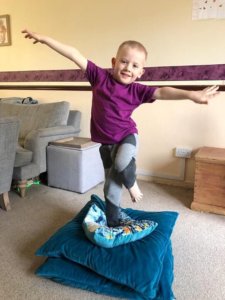
Once your child is walking confidently and able to negotiate obstacles, step over items and walk on uneven surfaces, try standing on 1 leg.
To start with, help your child to stand on 1 leg with a foot on a ball. They can start holding your hand during this but try to move on until they can do this not holding you.
Can they move the ball around in circles or forwards and backwards and side to side?
Now standing on 1 foot with the other foot in the air.
Can they still do this while throwing a ball in the air?
Now they should try to stand with 2 feet on a wobble cushion (a cushion with air in it) or just a small well stuffed pillow.
Can they do this on 1 leg?
And while throwing and catching?
How about on 1 leg and picking up a ball from the floor to play with skittles or target practice?






